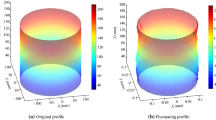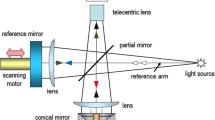Abstract
The cross-sectional method is undoubtedly the most widely used method of measuring cylindricity. The method consists of measurements of roundness profiles in several cross-sections of the cylindrical surface. Usually, the distance between subsequent cross-sections is equal. The number of cross-sections used depends on the required accuracy of the assessment of the cylindricity deviation. If one wants to get only rough estimation of the cylindricity deviation, then the measurement can be made in a few cross-sections only. However, if the required measurement accuracy is high, measurements should be carried out in a large number of cross-sections. The consequence of taking the measurements in a large number of sections is significant extension of the measurement time. In this work, an adaptive method of measuring cylindricity is proposed, the purpose of which is to ensure the required measurement accuracy while reducing the necessary number of cross-sections in which roundness profile measurements should be conducted. The proposed strategy is iterative and it is based on carrying out measurements in the cross-sections of the measured part. The proposed method implies two criteria: the correlation coefficient and the predicted values of the form deviations in the non-measured areas of the measured part. The paper presents the fundamentals of the method and the selected results of its practical verification. The experimental results show the ability of the new method to measure the form deviations of cylindrical parts.














Similar content being viewed by others
Data availability
All data are stored at the Laboratory of Computer-Aided Measurements of Geometrical Quantities (Kielce University of Metrology). Data can be provided to the reader on their request.
Code availability
Measurement data are stored as a part of Calypso software (IGES/DXF files).
References
Adamczak S, Stepien K, Zmarzły P (2017) An analysis of strategies of measurement of 3D rotary elements. Proceedings of the 28th DAAAM International Symposium on Intelligent Manufacturing and Automation Zadar, Croatia, pp 1096–1100. https://doi.org/10.2507/28th.daaam.proceedings.152
Janecki D, Zwierzchowski J, Cedro L (2015) A problem of optimal cylindricity profile matching. Bulletin of the Polish Academy of Sciences Technical Sciences 63(3):771–779
Stepien K, Janecki D, Adamczak S (2021) Fundamentals of adaptive strategy of cylindricity measurements with the use of longitudinal measurements. Meas: Sens 18:100146
Kong X, Zheng W, Ai M (2023) Representative points for distribution recovering. AI J Stat Plan Inference 224:69–83
Hernández-Mederos V, Estrada-Sarlabous J (2003) Sampling points on regular parametric curves with control of their distribution. Comput Aided Geom Des 20:363–382
Edgeworth R, Wilhelm RG (1999) Adaptive sampling for coordinate metrology. Precis Eng 23(3):144–154
Colosimo BM, Moroni G, Petro S (2010) A tolerance interval based criterion for optimizing discrete point sampling. Precis Eng 34:745–754
Lu W et al (2019) Uncertainty-guided intelligent sampling strategy for high-efficiency surface measurement via free-knot B-spline regression modelling. Precis Eng 56:38–52
Fei L, Dan L, Lin L, Guanghua X, Qing Z, Zixia M (2017) Sampling strategy and error estimation for evaluation of quadratic form error using Cartesian coordinate data. IET Sci Meas Technol 11:839–846
Heikka Riitta, Minkkinen Pentti (1998) Integration of the variogram using spline functions for sampling strategy and error estimation for evaluation of quadratic form error using Cartesian coordinate data sampling error estimation. Chemom Intell Lab Syst 44:205–211
Choi Woncheol, Kurfess Thomas R, Cagan Jonathan (1998) Sampling uncertainty in coordinate measurement data analysis. Precis Eng 22:153–163
Raghunandan R, Venkateswara RP (2008) Selection of sampling points for accurate evaluation of flatness error using coordinate measuring machine. Journal of Materials Processing Technology 202(1–3):240–245
Chan FMM, King TG, Stout KJ (1996) The influence of sampling strategy on a circular feature in coordinate measurements. Measurement 19:73–81
Peng Xiaonan, Liu Fei, Lei Xianqing (2008) Roundness error evaluation algorithm using coordinate measuring machine. Chin J Sci Instrum 29:1654–1658
Weber Timothy et al (2002) A unified approach to form error evaluation. Precis Eng 26:269–278
Chatterjee Goutam, Roth Bernard (1997) On Chebychev fits for pairs of lines and polygons with specified internal angles. Precis Eng 21:43–56
Gou JB, Chu YX, Li ZX (1999) A geometric theory of form, profile, and orientation tolerances. Precis Eng 23:79–93
Qing Liu C, Chuck Zhang H-P, Wang Ben (2001) On the effects of CMM measurement error on form tolerance estimation. Measurement 30:33–47
Raghunandan R, Rao P. Venkateswara (2007) Selection of an optimum sample size for flatness error estimation while using coordinate measuring machine. Int J Mach Tools Manuf 47:477–482
Capello E, Semeraro Q (2001) The harmonic fitting method for the assessment of the substitute geometry estimate error. Part I: 2D and 3D theory. Int J Mach Tools Manuf 41(8):1071–1102
Summerhays KD, Henke RP, Baldwin JM, Cassou RM, Brown CW (2001) Optimizing discrete point sample patterns and measurement data analysis on internal cylindrical surfaces with systematic form deviations. Precis Eng 26:105–121
Pedone P, Vicario G, Romano D (2009) Kriging-based sequential inspection plans for coordinate measuring machines. Appl Stochastic Models Bus Ind 25(2):133–49
Chen J, Ren Y, Zeng G (2015) An improved multi-harmonic sine fitting algorithm based on Tabu Search. Measurement 59:258–267
Hu P et al (2018) Automatic generation of efficient and interference-free five-axis scanning path for free-form surface inspection. Comput Aided Des 98:24–38
Yuan X et al (2020) The non-negative truncated singular value decomposition for adaptive sampling of particle size distribution in dynamic light scattering inversion. J Quant Spectrosc Radiat Transf 246:106917
Adamczak S et al (2010) Quantitative comparison of cylindricity profiles measured with different methods using Legendre-Fourier coefficients. Metrol Meas Syst 17(3):397–404
Funding
The paper has been elaborated within the framework of the research project entitled “Analysis of the possibility of using artificial intelligence in surface irregularities measurements,” financed by the Ministry of Education and Science of the program: Polish Metrology, Nr PM/SP/0021/2021 of 29.06.2022.
Author information
Authors and Affiliations
Contributions
Stanisław Adamczak’s contribution: general concept of the manuscript.
Dariusz Janecki’s contribution: development of the mathematical models and development of the software.
Krzysztof Stepien’s contribution: conducting the experiments, analysis of the results of experiments, writing the draft, and final conclusions.
Corresponding author
Ethics declarations
Conflict of interest
The authors declare no competing interests.
Additional information
Publisher's Note
Springer Nature remains neutral with regard to jurisdictional claims in published maps and institutional affiliations.
Supplementary Information
Below is the link to the electronic supplementary material.
Rights and permissions
Springer Nature or its licensor (e.g. a society or other partner) holds exclusive rights to this article under a publishing agreement with the author(s) or other rightsholder(s); author self-archiving of the accepted manuscript version of this article is solely governed by the terms of such publishing agreement and applicable law.
About this article
Cite this article
Janecki, D., Stępień, K. & Adamczak, S. Adaptive cylindricity measurements with the use of circumferential section strategy. Int J Adv Manuf Technol 132, 585–600 (2024). https://doi.org/10.1007/s00170-024-13404-2
Received:
Accepted:
Published:
Issue Date:
DOI: https://doi.org/10.1007/s00170-024-13404-2




